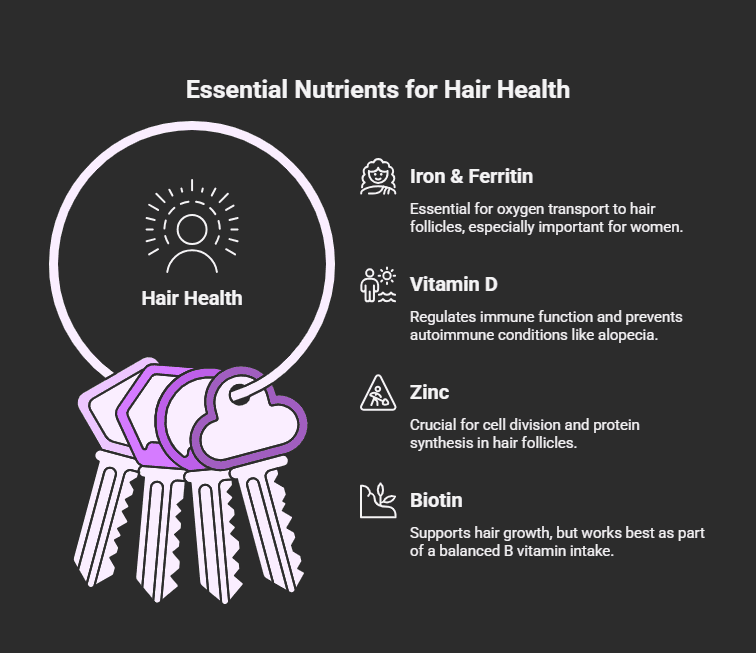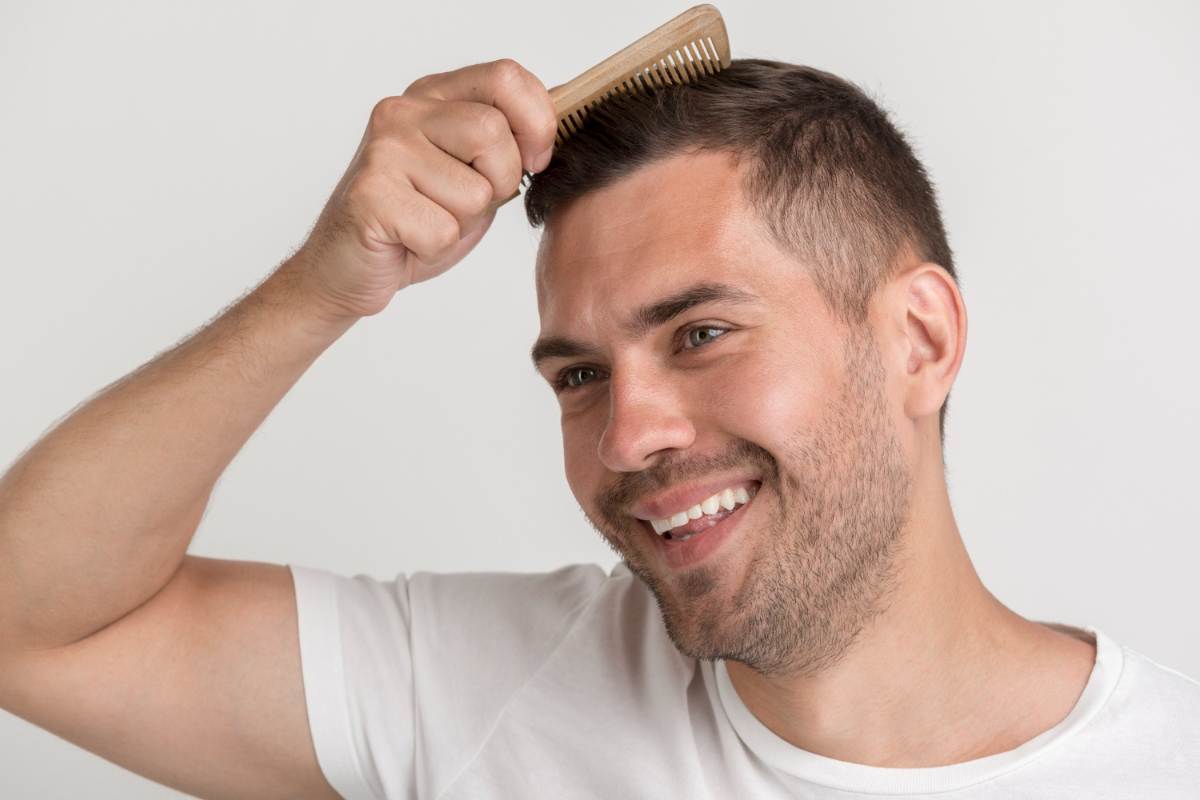It starts subtly. An extra few strands in the hairbrush. A slightly wider part. Then, one day, you see it under the harsh bathroom light, a spot. A patch. A thinning that wasn’t there before.
And the world kind of… stops.
That feeling, a cold, quiet dread that settles in your stomach, is something millions of us know all too well. Hair loss isn’t just about hair. It’s about identity, confidence, and how we face the world. Or how we feel the world is facing us. It can feel like a loss of control, a betrayal by your own body. So you do what anyone would do: you search for answers. You fall down the late-night internet rabbit hole, scrolling past clinical-looking websites and miracle-cure ads until your eyes burn.
The conventional route is there, of course. Steroid injections, topical creams, medications… and for many, they are a necessary and effective part of the journey. But what if you’re looking for something more? Something that feels less like a battle and more like… building. Building a foundation of health from the inside out.
That’s the real question, isn’t it? Can the choices we make every single day, what we put on our plate, how we manage our stress, and how we live our lives actually make a difference? Can we partner with our bodies to combat hair loss?
Let’s talk about it. Not in cold, clinical terms, but like people. People who’ve stared at their reflection and wondered, “What now?”
Because there is a “what now?” And it’s more hopeful than you might think.
First Things First: What Are We Even Dealing With?
Before we dive in, let’s get on the same page. “Alopecia” is just the medical term for hair loss. But it’s not one-size-fits-all.
You’ve got Alopecia Areata, which is what most people think of, an autoimmune condition where your own immune system gets confused and starts attacking your hair follicles. It shows up as those classic round, smooth patches of hair loss. Sometimes it can be more extensive, leading to total scalp hair loss (Alopecia Totalis) or even complete body hair loss (Alopecia Universalis). This type is notoriously unpredictable. A real wild card.
Then there’s Androgenetic Alopecia, which is male and female pattern baldness. This one’s more about genetics and hormones. It’s a slower, more predictable thinning over time.
And let’s not forget Telogen Effluvium, the sudden, diffuse shedding that can happen after a major shock to your system, think childbirth, major surgery, a period of intense stress, or a severe illness.
Why does this matter? Because knowing what you’re up against helps tailor the approach. An autoimmune trigger might respond differently to certain interventions than hormonal thinning. But here’s the kicker: many of the foundational, natural approaches we’re about to explore? They benefit all of them. Because they’re not just about hair. They’re about creating balance in the body.
The Elephant in the Room: Can You Really ‘Cure’ Hair Loss with Food?
Okay, let’s be brutally honest. Is there a magic salad that will make your hair grow back overnight? No. Of course not. And anyone who tells you otherwise is probably selling something.
But to dismiss diet and lifestyle is to miss the entire point.
Think of your body as a garden. If the soil is depleted, lacking nutrients, and overrun with pests (hello, inflammation and stress), how can you expect anything beautiful to grow? You can’t just sprinkle some “hair growth” seeds on top and hope for the best. You have to tend to the soil. You have to nourish it, protect it, and give it what it needs to thrive.
The food you eat, the air you breathe, the stress you carry… that’s your soil. And your hair follicles are the seeds. So, let’s get our hands dirty and start tending to that garden.
The Anti-Inflammatory Kitchen: Your First Line of Defense
Inflammation is a word we hear all the time. But what is it? In the short term, it’s your body’s heroic response to injury or infection. A good thing. But when it becomes chronic, a low-grade, simmering fire that never goes out, it can lead to all sorts of trouble. And for those with autoimmune conditions like alopecia areata, that fire is a major, major problem.
Your mission, should you choose to accept it, is to become a firefighter. And your tools are in your kitchen.
- Go Green. And Red. And Orange. Think of colors. Deep, vibrant colors. Dark leafy greens like spinach and kale are packed with antioxidants. Berries, blueberries, raspberries, and strawberries are little antioxidant powerhouses that fight off cellular damage. Sweet potatoes, carrots, bell peppers… eat the rainbow. Seriously. It’s not just a cute saying; it’s a strategy.
- Embrace Healthy Fats. Not all fats are created equal. The fat in a greasy takeaway burger is not the same as the fat in an avocado or a handful of walnuts. You’re after Omega-3 fatty acids, the ultimate inflammation-busters. Find them in fatty fish like salmon, mackerel, and sardines. If you’re plant-based, flaxseeds, chia seeds, and walnuts are your best friends. These fats don’t just cool inflammation; they are part of the structure of your cell membranes. They’re foundational.
- Spice Up Your Life. Certain spices are ridiculously potent anti-inflammatories. Turmeric is the king here, with its active compound curcumin. (Pro tip: always have it with a pinch of black pepper, which dramatically increases its absorption). Ginger is another giant, great for calming the gut and the immune system. Sprinkle them into your cooking, sip them in teas… get creative!
The Gut-Hair Connection… No, Really.
If you’d told someone 20 years ago that the bacteria in their gut could affect the hair on their head, they’d have laughed you out of the room. But believe it or not, this is one of the most exciting frontiers in health research.
Your gut is home to trillions of microorganisms, your microbiome. This internal ecosystem is like a command center for your immune system. About 70-80% of your immune cells live in your gut. When your gut microbiome is out of whack (a state called “dysbiosis”), your immune system can get confused. It can become overactive and trigger-happy. And for someone with a predisposition to alopecia areata, that’s like pouring gasoline on a fire.
So, how do you cultivate a healthy gut garden?
- Probiotics Are Your Pals. These are the good guys, the beneficial bacteria. You’ll find them in fermented foods like plain yogurt, kefir (a fermented milk drink that’s even more potent than yogurt), sauerkraut, kimchi, and kombucha. Introducing these foods helps to repopulate your gut with friendly microbes.
- Feed the Good Guys with Prebiotics. Probiotics need to eat, too. Their favorite food is fiber, specifically, prebiotic fiber. Think of it as fertilizer for your inner garden. Amazing sources include garlic, onions, leeks, asparagus, bananas, and oats.
- Ditch the Sugar. If prebiotics are fertilizer for the good guys, sugar is junk food for the bad guys. Pathogenic yeasts and bacteria love sugar. It helps them multiply, crowd out the good microbes, and contribute to that chronic, simmering inflammation. I know, I know. It’s tough. But cutting back on refined sugar and processed foods might be one of the most powerful things you do for your gut, and by extension, your hair.
The Building Blocks: Are You Getting Enough of the Good Stuff?

Beyond the big picture of inflammation and gut health, there are specific micronutrients that are non-negotiable for healthy hair follicles. A deficiency in any one of these can, at best, prevent healthy growth and, at worst, actively cause shedding.
- Iron (and its friend, Ferritin): This is a big one, especially for women. Iron is essential for producing hemoglobin, which carries oxygen in your blood. And your hair follicles? They need a lot of oxygen to thrive. But it’s not just about your iron level; it’s about your ferritin level. Ferritin is the protein that stores your iron. Think of it as your iron savings account. Many doctors see ferritin levels within the “normal” lab range and say you’re fine, but many trichologists (hair specialists) will tell you that for optimal hair growth, you want that ferritin level to be well above 50, even closer to 70 ng/mL. Get it checked! If it’s low, focus on iron-rich foods like red meat (if you eat it), lentils, spinach, and tofu. And always pair them with Vitamin C (like a squeeze of lemon juice on your lentils) to boost absorption.
- Vitamin D (The Sunshine Vitamin): This isn’t just a vitamin; it’s a hormone that plays a massive role in immune function. Low levels of Vitamin D are strongly linked to a whole host of autoimmune conditions, including, you guessed it, alopecia areata. It helps to regulate the immune system, hopefully telling those confused T-cells to stand down. We get it from the sun, but many of us are still deficient. Fatty fish and fortified foods have some, but supplementation is often necessary. Again, get your levels checked. Don’t just supplement blindly.
- Zinc (The Master Mineral): Zinc is like the hardworking foreman on a construction site. It’s involved in hundreds of enzymatic reactions in the body, including cell division and protein synthesis. Hair follicles have a very high rate of cell turnover, so a zinc deficiency can bring that process to a screeching halt. It’s also crucial for a healthy immune system. Find it in oysters (the richest source by far!), beef, pumpkin seeds, and lentils.
- Biotin (The Famous One): Ah, biotin. It’s marketed as a hair vitamin. And while a true biotin deficiency (which is very rare) can cause hair loss, just taking massive doses of it probably won’t do much if your levels are already normal. It’s one piece of a much larger puzzle. Your body needs all the B vitamins working in concert. So instead of just a biotin pill, think about foods rich in B vitamins, like eggs, salmon, and leafy greens.
It’s Not Just What You Eat… It’s How You Live
You could be eating the most perfect, anti-inflammatory, nutrient-dense diet on the planet, but if you’re a walking ball of stress who sleeps four hours a night, you’re still fighting an uphill battle. A massive one.
Lifestyle isn’t the icing on the cake. It is the cake.
The Stress Spiral: Breaking Up with Cortisol
Let’s talk about stress. Not just “I have a deadline” stress, but the deep, chronic stress that comes from worry, anxiety, and, well, losing your hair. It’s a vicious cycle, isn’t it? You stress about your hair, and that stress makes your hair situation worse.
When you’re chronically stressed, your body is marinating in a hormone called cortisol. In the short term, cortisol is life-saving. But long-term? It wreaks havoc. It disrupts your immune system, messes with your gut, and can prematurely push your hair follicles from the growing phase (anagen) into the shedding phase (telogen).
You can’t eliminate stress. But you can change your relationship with it. You can build resilience.
- Breathe. Just Breathe. This sounds so simple, it’s almost insulting. But it’s profound. When you’re anxious, your breathing becomes shallow and rapid. Taking slow, deep belly breaths activates the vagus nerve, which is the superhighway of your parasympathetic nervous system, the “rest and digest” system. It’s a physiological off-switch for the stress response. Try it right now. A four-second inhale, a seven-second hold, and an eight-second exhale. Do it three times. Feel that? That’s you taking back control.
- Mindfulness & Meditation: This isn’t about emptying your mind. It’s about noticing your thoughts without getting swept away by them. It’s about creating a space between you and your anxieties. Apps like Calm or Headspace are fantastic starting points. Even five minutes a day can begin to rewire your brain’s response to stress. It’s exercise for your mind.
- Move Your Body (Gently): Intense, grueling workouts can be another stressor on the body. But gentle movement? It’s magic. Think yoga, with its combination of movement, breathing, and mindfulness. Or Tai Chi. Or simply a long walk in nature, which studies have shown can measurably reduce cortisol levels. It’s about circulation, yes, but it’s more about tranquility.
Sleep: The Unsung Hero of Hair Health
Sleep is when your body does its repair work. It’s when you produce growth hormone, when your cells regenerate, when your brain detoxifies. If you’re skimping on sleep, you are robbing your body of its most critical healing time. Period.
Aim for 7-9 hours of quality sleep. This means practicing good sleep hygiene:
- Make your room dark, cool, and quiet.
- No screens (phone, TV, laptop) for at least an hour before bed. The blue light messes with your melatonin production.
- Try to go to bed and wake up around the same time every day, even on weekends. Your body loves a routine.
Exploring the Path Less Traveled: Alternative Approaches
Okay, so we’ve tended the soil with diet and managed the weather with lifestyle. What else is in the toolkit? This is where we venture into complementary therapies. The key word here is complementary; they work alongside, not necessarily instead of, other approaches.
Scalp Love: Massage and Essential Oils
This feels good, and it might do good, too. Gently massaging your scalp for a few minutes every day can help to increase blood flow to the follicles, bringing all those lovely nutrients you’re eating right to their doorstep.
You can supercharge your massage with a few drops of certain essential oils diluted in a carrier oil (like jojoba or coconut oil).
- Rosemary Oil: This is the star player. Some fascinating studies have shown it to be as effective as 2% minoxidil (the active ingredient in Rogaine) for androgenetic alopecia, without the side effects of an itchy scalp. It’s thought to work by improving circulation and inhibiting a hair-unfriendly hormone called DHT.
- Peppermint Oil: Ever used it? That cool, tingling sensation is from the menthol increasing circulation in a big way. More blood flow = happier follicles.
- Lavender Oil: Known for its calming properties, it can help with the stress component, and some studies suggest it may have properties that promote cell growth.
Crucial caveat: Never, ever apply essential oils directly to your scalp. They are incredibly potent and can irritate. Always dilute a few drops into a tablespoon of a carrier oil and do a patch test on your skin first. Think of this less as a “treatment” and more as a ritual of self-care. A moment to connect with your body in a positive, nurturing way.
Ancient Wisdom: A Nod to Acupuncture
Acupuncture, a cornerstone of Traditional Chinese Medicine, is all about restoring the flow of energy, or “qi,” in the body. From a Western perspective, it’s thought to work by stimulating nerves, reducing inflammation, and increasing blood flow. For alopecia areata, an acupuncturist might focus on points related to immune function and stress reduction. Some people find it incredibly relaxing and see it as a way to re-establish balance in a body that feels out of control.
Tying It All Together: This Is a Marathon, Not a Sprint
Whew. That’s a lot. And if you’re feeling a little overwhelmed, take a deep breath. (Remember? Four-seven-eight).
You do not have to do all of this tomorrow. You shouldn’t.
This isn’t about a frantic, perfectionistic overhaul. That’s just another form of stress. It’s about choosing one thing. Just one.
Maybe this week, you decide to add a big handful of spinach to your smoothie every morning. Great. That’s a win.
Maybe next week, you commit to a five-minute breathing exercise before you check your phone in the morning. Amazing.
This is a journey of a thousand small steps. It’s about patience, consistency, and, most importantly, kindness to yourself. There will be good days and bad days. Days when you eat the kale salad, and days when you eat the cake. It’s okay. The goal is progress, not perfection.
And here’s the most important part: talk to a professional. A good dermatologist can give you an accurate diagnosis, which is critical. A registered dietitian or a naturopathic doctor can help you come up with a personalized plan and check for nutrient deficiencies. Build a team. You don’t have to do this alone.
Losing your hair is a deeply personal, often painful experience. But the journey to reclaim your health can be an empowering one. It’s a chance to tune in, to listen to what your body has been trying to tell you. It’s about taking back the reins, not by fighting your body, but by nourishing it, supporting it, and giving it everything it needs to heal.
And who knows? In the process of cultivating this beautiful, healthy inner garden… You might just find that some very welcome new growth begins to sprout.








